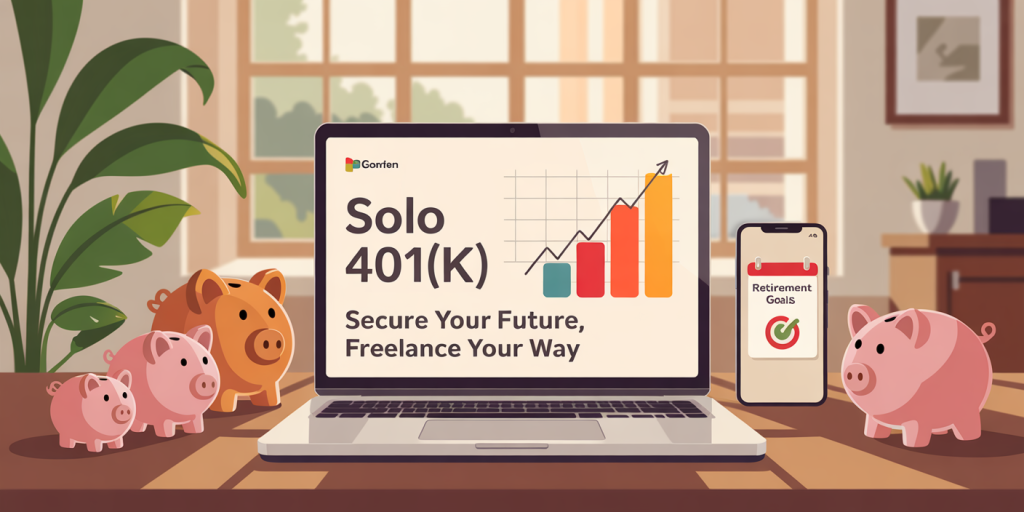Financial Planning for Freelancers: Building Stability in an Unpredictable Income Landscape
Freelancers represent a rapidly growing segment of the global workforce. According to a 2023 report by Upwork, approximately 57 million Americans engage in freelance work, contributing around $1.4 trillion to the U.S. economy annually. This growth reflects the increasing appeal of flexible work arrangements, independence, and autonomy. However, such freedom comes with significant financial planning challenges stemming from irregular income streams, lack of employer-provided benefits, and limited access to traditional financial safety nets.

Freelancers must develop tailored financial strategies that accommodate unpredictability while ensuring long-term stability. This article explores the essentials of financial planning specifically for freelancers, highlighting key areas including budgeting, tax planning, retirement saving, insurance, and investment. Drawing on practical examples, data, and comparative insights, we aim to empower freelancers with the tools to manage their financial health proactively.
—
Understanding the Freelance Income Cycle and Its Impact on Budgeting
Income variability is arguably the most defining characteristic of freelance work. Unlike salaried employees with consistent monthly paychecks, freelancers often experience fluctuating earnings due to project-based contracts, seasonal demand, or client delays. A study by the Freelancers Union shows that 46% of freelancers admit to struggling with unpredictable cash flow, underscoring the need for careful budgeting.

To address these fluctuations, freelancers must adopt a flexible yet disciplined budgeting approach. Unlike traditional budgets, a freelancer’s budget needs to prioritize establishing a “baseline income” that covers essential expenses during low-income periods. For instance, if a freelancer’s average monthly necessary expenses total $3,000, they should aim to secure at least this amount every month through savings or reliable contracts before allocating funds to discretionary spending.
Practical Example: Consider Sarah, a graphic designer who earns between $2,500 and $6,000 per month. To smooth out volatility, Sarah tracks a 12-month average of her income to project realistic monthly earnings. She then categorizes expenses as fixed (rent, utilities, subscriptions) and variable (dining out, entertainment) and cuts down variable expenses when income is below average. This dynamic budgeting method allows Sarah to maintain financial stability without compromising necessary lifestyle elements.
A useful technique is the “zero-based budget,” where every dollar earned is assigned a purpose—savings, expenses, taxes, or investments—until no money remains unallocated. Freelancers can adapt this by creating buffer zones within their budgets dedicated to irregular expenses like health costs or equipment upgrades.
—
Tax Planning: Navigating Complex Obligations and Maximizing Deductions
Tax responsibility is a major area where freelancers face complexity and risk. Unlike employees who have taxes withheld, freelancers must manage quarterly estimated tax payments, track deductible expenses, and maintain accurate records to avoid penalties. According to the IRS, failing to pay quarterly taxes can lead to fines and interest, making proactive tax planning essential.
A key strategy involves understanding permissible deductions. Freelancers can deduct expenses directly related to their work, including home office space, software subscriptions, freelance platform fees, travel expenses, and even a portion of utilities. For example, John, a freelance software developer, deducts 20% of his home electricity bill based on the square footage dedicated to his home office. Additionally, he records travel expenses when attending client meetings or industry conferences.
Freelancers should also consider setting aside 25-30% of their monthly income exclusively for taxes to cover federal, state, and self-employment taxes. Using accounting software such as QuickBooks Self-Employed or FreshBooks can simplify tracking expenses and calculating quarterly estimates.

Comparative Table: Employee vs Freelancer Tax Responsibilities
| Aspect | Employees | Freelancers |
|---|---|---|
| Tax Withholding | Automatically by employer | Responsible for quarterly payments |
| Deductible Expenses | Limited deductions (e.g., standard deduction) | Business-related expenses deductible |
| Social Security & Medicare | Employer contributes half | Full contribution paid by freelancer (self-employment tax) |
| Record Keeping | Minimal | Essential for compliance and deductions |
| Tax Filing Frequency | Annually | Quarterly estimated payments + annual filing |
By proactively managing these tax obligations, freelancers can avoid year-end surprises and optimize their financial resources.
—
Retirement Saving for Freelancers: Building Wealth Independently
One of the biggest challenges freelancers face is the lack of employer-sponsored retirement plans such as 401(k)s or pensions. Without automatic payroll deductions or company matches, freelancers must be disciplined and strategic in setting aside funds for retirement. Data from the National Institute on Retirement Security indicates that nearly 60% of self-employed individuals have no retirement savings, highlighting a critical vulnerability.
Retirement Savings Strategies: Freelancers have access to various retirement accounts suited to their unique needs: Solo 401(k): Ideal for freelancers with no employees, allowing contributions as both employee and employer, with a 2024 contribution limit up to $66,000 (including catch-up contributions for those over 50). SEP IRA (Simplified Employee Pension): Allows contributions based on net earnings from self-employment, with a limit of 25% of income or $66,000 for 2024. Traditional or Roth IRA: Offers flexibility but with lower annual contribution limits ($6,500 for 2024 plus $1,000 catch-up if over 50).
Practical Example: Michael, a freelance writer earning $70,000 annually, contributes $20,000 to his Solo 401(k) every year, effectively reducing his taxable income while accumulating retirement savings. By automating monthly contributions through his bank, he ensures consistent savings irrespective of income fluctuations.
Freelancers should prioritize retirement savings as part of their overall financial plan, considering the power of compound interest and the variability of freelance income in later years.
—
Insurance and Risk Management: Protecting Freelance Income and Health
Health insurance, disability protection, and liability coverage are critical components of a freelancer’s financial safety net. Unlike traditional employees who benefit from group insurance plans, freelancers must often purchase private health insurance and consider additional policies independently.
According to a Kaiser Family Foundation study, about 27% of freelancers report lacking health insurance, underscoring a significant risk area. The Affordable Care Act (ACA) Marketplace provides options for individuals, sometimes with income-based subsidies. Freelancers need to budget carefully for premium costs, which can range from $400 to $700 monthly depending on coverage level and location.
Risk management also involves disability insurance, which replaces income if illness or injury prevents work. Private disability insurance or plans through associations like the Freelancers Union can offer protection against prolonged work interruption. For example, Lisa, a freelance photographer, secures a short-term disability policy that covers 60% of her income after a two-week waiting period, ensuring she can still pay bills during recovery from an accident.
Additionally, professional liability insurance (errors and omissions insurance) is advisable for freelancers delivering client services to protect against lawsuits resulting from work mistakes or negligence.
—
Investment Strategies for Freelancers: Growing Wealth Amid Uncertainty
While immediate financial concerns such as budgeting and taxes dominate freelancers’ priorities, long-term wealth growth requires thoughtful investment planning. Given the fluctuating cash flow, freelancers might find it challenging to commit consistent funds to investments, yet even small, regular contributions can facilitate wealth accumulation.
Diversification is key in investment strategy. Freelancers should consider balancing low-risk vehicles such as high-yield savings accounts and bonds with higher-return options like stocks or mutual funds, aligned to their risk tolerance and financial goals.
Comparative Table: Investment Options for Freelancers
| Investment Type | Risk Level | Liquidity | Minimum Investment | Benefits |
|---|---|---|---|---|
| High-Yield Savings Account | Low | High | Low | Principal safety, quick access |
| Bonds (Government/Corporate) | Low to Moderate | Moderate | Moderate | Steady income, lower volatility |
| Mutual Funds/ETFs | Moderate | Moderate | Low to Moderate | Diversification, professional management |
| Individual Stocks | High | High | Varies | High growth potential, higher volatility |
| Real Estate Investment Trusts (REITs) | Moderate | Low to Moderate | Moderate | Income, portfolio diversification |
Sarah, the graphic designer referenced earlier, allocates 15% of her profits monthly into a Roth IRA focused on index funds. This approach ensures tax-advantaged growth despite income variability.
Financial advisors often recommend establishing an emergency fund covering 6 to 12 months of essential expenses before aggressive investing, a recommendation particularly vital for freelancers facing uncertain income.
—
Future Perspectives: The Evolution of Freelance Financial Planning
As the freelance economy continues to expand, technological advancements and policy changes promise new opportunities and challenges in financial planning. Platforms like Payoneer and Deel increasingly offer integrated financial services tailored to freelancers, including automated tax withholding, invoicing, and payment management—features that can simplify financial planning.
Moreover, legislative efforts aimed at extending portable benefits, such as the proposed Freelance Isn’t Free Act enhancements or portable retirement accounts, could significantly improve freelance financial security in the coming decade. This policy momentum could close existing gaps in health insurance, unemployment benefits, and retirement savings access.
On a personal finance front, increased adoption of AI-driven finance apps equipped with predictive algorithms may help freelancers forecast income and expenses with greater accuracy, propose optimized tax strategies, and automate savings—even adapting in real time to fluctuating contracts or market conditions.
Case in Point: A recent pilot project by a fintech startup integrates AI with freelance marketplaces, offering instant insights on optimized pricing, tax estimates, and financial goal tracking. Freelancers using such platforms report a 25% improvement in cashflow management and reduced tax payment errors.
In conclusion, freelancers who adopt a proactive, multifaceted approach to financial planning—combining disciplined budgeting, tax efficiency, retirement preparation, insurance coverage, and smart investing—will be best positioned to thrive in an economy where non-traditional work arrangements are the norm. The future holds promising tools and policies that could further empower this dynamic workforce, but the onus remains on individual freelancers to claim financial stability and growth through informed decision-making today.
